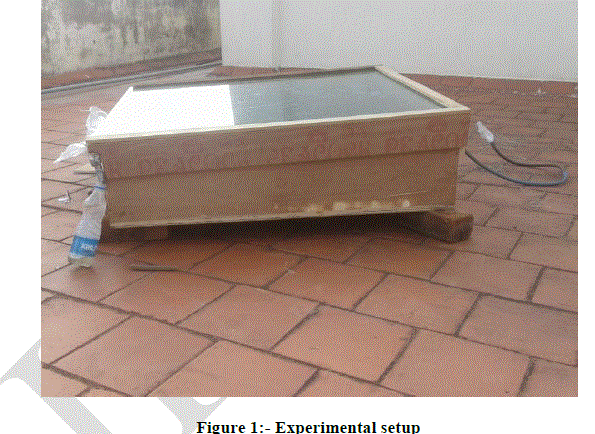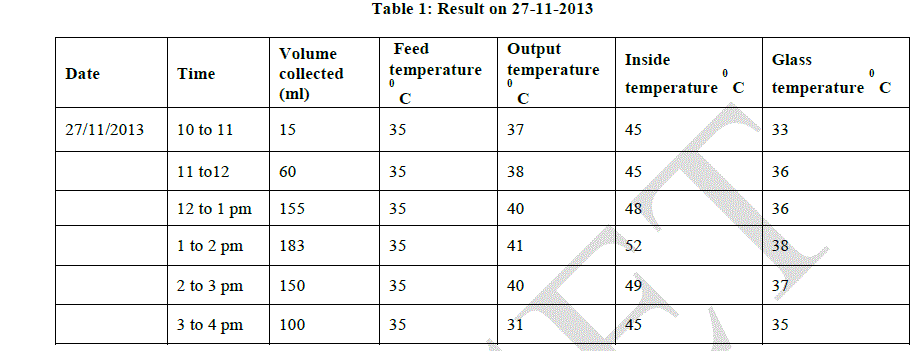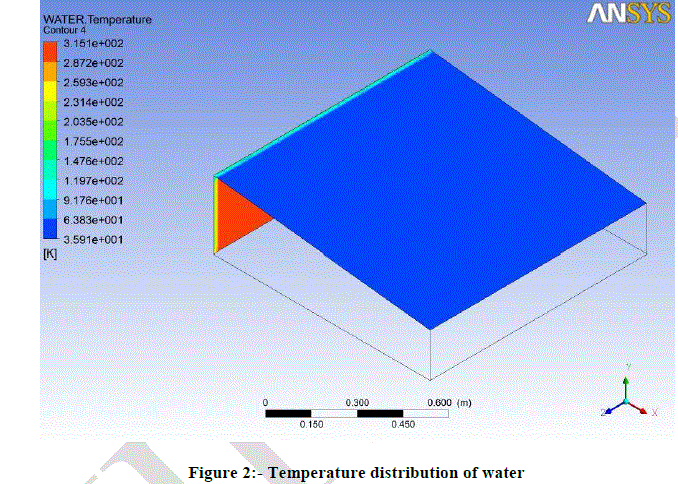ISSN ONLINE(2319-8753)PRINT(2347-6710)
ISSN ONLINE(2319-8753)PRINT(2347-6710)
N.Sri Gokilavani1, Dr.D.Prabhakaran2, Dr.T.Kannadasan3
|
| Related article at Pubmed, Scholar Google |
Visit for more related articles at International Journal of Innovative Research in Science, Engineering and Technology
An attempt is made to model a conventional solar distillation system and comparing the experimental results with simulated model. Solar distillation is an old process, but cost wise and for domestic purpose it is most reliable one. Evaporation and Condensation are the simultaneous process occurring in solar distillation. The property of the distilled water is measured. It is evident that, the distilled water produced by solar still is quite resembles the commercial distillation water. Experimental work was compared with simulation study. Temperature distribution over the glass is verified with Computational Fluid Dynamic approach using Ansys. The computational result is validating with the experiment work.
Keywords |
| Ansys, Computational Fluid Dynamics, conventional, distilled water, solar distillation. |
INTRODUCTION |
| Seawater desalination is best adapted process for counties like India. Here we have high amount of solar energy. Solar distillation systems normally consist of wood or steel plate to increase intensity of the sunlight. These systems are basically composed of a top glazed cavity containing a saline water layer, which is heated by the transmitted solar radiation through the top glazing cover. A very large-scale process is used for fresh water production. Evaporation and condensation is the main process taking place. The essential features of this process are thus summarized as the production of vapors above the surface of the liquids, the transport of vapors by winds, the cooling of air– vapor mixture, condensation and precipitation. According to World Health Organization (WHO), the permissible limit of salinity in water is 500 ppm and for special cases up to 1000 ppm while most of the water available on earth has the salinity up to 10,000 ppm whereas seawater normally has salinity in the range of 35,000 – 45,000 ppm in the form of total dissolved salts. Excess brackishness causes various problems in human health. One of the control measures includes supply of water with total dissolved solids within permissible limits of 500 ppm or less. This is accomplished by several desalination methods like reverse osmosis, electro dialysis, vapor compression, multistage flash distillation, multiple-effect distillation and solar distillation, which are used for purification of water. On the other hand, compared to RO, Walton et al, [16] reported that, when fully developed, Membrane Distillation (MD) should be significantly lower in capital and operational expenses for remote areas. Tanaka et al, [13] found for a tilted wick-type solar still that an increase in productivity is 20–50% more than basin-type solar stills. Despite the prospects of solar MD systems, very few experimental systems have been developed as opposed to the mature solar PV-driven RO and solar distillation technologies [8]. de Koning & Thiesen [4], introduces a compound solar distiller that has additional side mirrors, great energy efficiency, and may produce some 40 L/(m2/d). Cipollina et al. [3], considers the environmental sustainability of desalination due to the large flow rates of hot brine dissipated into the sea and proposes coupling a solar still plant with an existing thermal desalination installation so as to improve the overall desalination process while mitigating the environmental impact. Tiwari et al., [14] worked out computer modeling of passive/active solar stills by using inner glass temperature for limited period. However, they have not considered this effect in thermal modeling. The thermal dynamic effects of material used for manufacturing solar stills in combination with weather parameter has been studied by Porta et al. [11]. This research is purely based on experimental and computational approach of solar distillation system. Property of the distilled water is tested to check the quality of the process. |
II. MATERIAL AND METHOD |
| Typical solar system consists of wooden box and sheet metal tray. Top of the system is covered by glass in order to increase the solar intensity. Thickness of the sheet metal is 3mm and thickness of glass is 2 mm. Wood is used to minimize heat loss from the system. Evaporation and condensation is the process taking place. Salt water is filled in the system and allowed to get evaporated in sunlight. Temperature of inside water, outlet water and glass are measured at one hour once. Optimum evaporation is achieved at noon. Water vapor gets condensed in glass cover. Provision is made to collect the condensed distilled water. Quality of the water is analyzed using Water analyzer. Property of the distilled water quite matched with the process out let water. Experiment is carried out from 10.00 A.M to 4.00 P.M with time interval of one hour. Experiment setup is shown below in figure 1. Experiment is carried out in college campus in the month of August. It also repeated in month of April, where we get high solar intensity. The rate of evaporation is high in this month. |
 |
III. RESULTS AND DISCUSSION |
| Salt water was filled in the tray for 14 cm height. Salt water prepared resembles the salinity of sea water (i.e., 35 g/l). The salt water was allowed to get heated in the open atmosphere. One hour once distilled water was collected and the quality was verified. Temperature of the salt water, glass temperature and distilled water temperature were noted. Two days the experiment was conducted and the results are given below in table 1 and 2. It is evident that at the time of 1 P.M to 2 P.M, distilled water collected is high compared to other time intervals. At this time solar intensity also high compared to the rest. Temperature of the distilled water will not affect its property. Examined property of the distilled water is given in table 3. |
 |
IV. MODELING AND SIMULATION |
| Computational Fluid Dynamics approach was used to study the temperature distribution in the system. Model geometry and meshing were done using Ansys workbench 14.5. CFD prediction results become insignificantly closer to the experimental work. Attention in made to concentrate on the temperature distribution over the glass surface which is used as top cover. Water temperature predicted is compared to the experimental data. Simulation was carried out for one hour with all initial conditions. Figure 2 shows temperature distribution of water in the contour plot. |
 |
V. CONCLUSION |
| In this work, solar evaporation of salt water is simulated using Ansys CFX. Due to solar radiation, salt water gets evaporated and condensed in the surface of the cooled glass surface. Improved condensation can be achieved by passing cold water onto the surface of glass. Condensed water droplets were collected in a downcomer. Properties of water were analyzed. Simulation results were similar to experimental results. This result shows that CFD simulation is a powerful tool for parameter analysis and design of solar still. |
References |
|